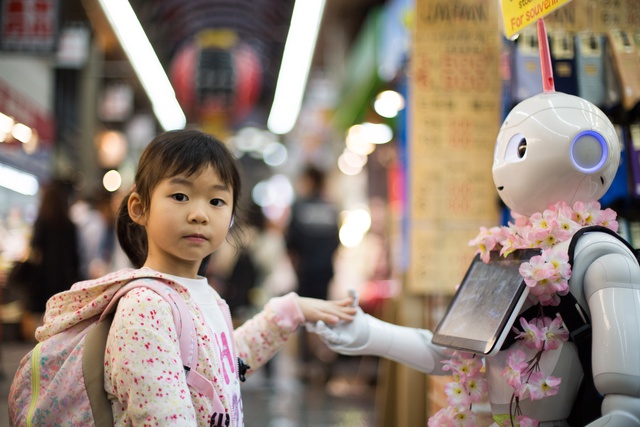AI Is Upturning How We Communicate With Our Audiences
12.12.23
Steven Franklin is Social Media Manager at The Royal Institution. On the rare occasions he's trying not to game social algorithms, he can be found thinking about how Arts and Cultural organisations can embrace emerging digital platforms and technologies.
This is the fourth piece in a series of blog posts on AI in the Arts. Click to read our first, second and third posts!
The Arts and Culture sector isn’t famed for being at the vanguard of cultural change.
However, AI will – and is already beginning to – fundamentally alter the way our sector works. Even the temperature-controlled environs of the museum display or art gallery are not resistant to the allure of this rapidly developing technology.
From my own perspective, I’d argue that AI is poised to revolutionise the way people work in communications and digital content creation for the sector.
Content Creation
Working as a social media manager feels like a real privilege, principally because there are so many avenues available for creative expression. Whether it’s writing snappy copy for X/Twitter or trying to make a viral TikTok, it’s rare for two days to feel the same.
But sometimes you feel the pressure to constantly create at times when you’re battling creative block just to appease the algorithm gods. And this is one area in which generative AI, such as ChatGPT, really can help.
AI algorithms can already assist with the writing of copy for blogs, event promotional copy, video scripts or the creation of clickbait titles. Equally, you can input an outline structure and let generative AI expand upon this, producing material that reflects your initial thoughts.
Outside of the world of written copy, there are also efficiencies to be had in the world of design.
For instance, AI can be used to create eye-catching visuals, logos, and design promotional materials (through tools like DALL-E-3, Midjourney and Stable Diffusion). We’ve witnessed an explosion of generative AI tools that can create images from scratch; even Canva has hopped on the AI bandwagon, offering various ways in which AI can help with the creation of visual assets.
AI is already playing a crucial role in social media management by automating tasks such as content scheduling, monitoring brand mentions, and the analysis of social media metrics.
Social listening tools, powered by AI, allow marketers to monitor conversations about their brand in real-time. AI also enables the automation of routine social media interactions, freeing up time for marketers to focus on more strategic aspects of their campaigns.
Audience Engagement
Chatbots and virtual assistants powered by AI can provide real-time interaction with audiences, offering information, answering queries, and even assisting in ticket purchases.
Moreover, AI-driven recommendation systems can help audiences discover new artists, performances, or exhibitions based on their preferences and past interactions. This personalised curation could lead to more tailored cultural experiences.
The integration of AI into our audience engagement strategies will eventually extend to virtual and augmented reality experiences. AI has the ability to enhance virtual tours, allowing audiences to explore exhibitions remotely and interact with digital collections. The possibilities of what this technology might allow are genuinely quite exciting and the potential is there to radically change the way audiences around the world engage with the work of arts and cultural institutions.
Data-Driven Decision Making
One of the most significant contributions of AI to marketing and communications is its ability to process vast amounts of data at speed. Traditional methods of market research and consumer analysis are often time-consuming and may not capture the full spectrum of relevant information. AI, on the other hand, can analyse massive datasets in real-time, providing us with valuable insights into consumer behaviour, preferences, and market trends.
Machine learning algorithms enable us to identify patterns and correlations within data, helping make informed decisions. By leveraging AI-driven analytics, we’re able to tailor our strategies to align with the ever-changing demands of the market, ensuring that marketing and communications campaigns are more targeted, personalised, and effective.
Digital literacy is vital
Continuous learning and improved digital literacy are key as this technology evolves. It is imperative that professionals within the arts and cultural sectors stay on top of the latest developments in AI technology. Traditionally, technical training has been an issue that has plagued those working within the sector, with smaller teams and tighter budgets often resulting in a need to prioritise getting work completed to the detriment of experimenting and using new technologies.
The integration of AI into our working lives is an inevitability and other industries will undoubtedly reap efficiency rewards. Arts and Culture organisations need to invest both time and money or risk being left behind.
Undoubtedly, AI brings with it unlimited possibilities for our future working lives. Though, as outlined in other blogs within this series, there are some serious considerations and ethical conversations that need to be at the forefront of our minds. As ever though, one fears that the potential positive impacts of AI in the Arts and Culture sector is very much reliant upon a commitment to improve digital literacy within the sector through the investment of time and resource.
Want to know how AI could help your marketing campaigns? Contact us at Mobius!
If you'd like to keep up to date with all our blog posts, important and interesting stories in the worlds of theatre, arts and media, plus job ads and opportunities from our industry friends, sign up to our daily media briefing at this link.



